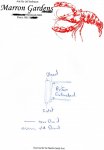Here's one for you. Any thoughts?
I'm changing brake fluid; replacing ATE Racing Super Blue with ATE Type 200 Amber. ( By the way, do you know that Racing Blue is no longer manufactured/ But that's another story. )
Should be a straightforward job, right? I am using the Motive Power Bleeder. Siphon out as much blue as I can from master cylinder. Fill bleeder with amber, pump up to 15 psi, and start bleeding. Fluid flow starts out as clearly blue, then begins to fade, goes to almost clear, but doesn't go to clearly amber in color. Same for all four calipers. At end of process, there is still blue fluid visible in master cylinder - a layer about 1 inch deep, and it is sitting on top of what is clearly bright amber fluid that occupies the balance of the master. This is weird to me.
I wonder if there is a difference in the specific gravities of the two fluids. Call ATE, and they say " no, the properties of the two fluids are the same except for color. " Talk with Motive, and they say they have not seen this before.
Today, I draw off as much of the blue fluid from the top of the master cylinder as I can, and then repeat the bleeding process, using more fresh amber fluid. Still getting blue fluid at each wheel to start with. Not as dark as yesterday, but clearly blue. Changes to progressively lighter blue, and then goes sort of clear in appearance. Does not turn to full amber color. At end of 4 wheel process, master cylinder still looks from the side as if it has a layer of blue sitting on top of amber - perhaps 1/8 inch deep. Looking into master cylinder from the top, the fluid you can see is definitely amber. Perhaps the master cylinder is discolored from the blue at the "max" level, and that is what I am seeing from the side.
At this point, I don't know whether to repeat the process again, or if it is OK the way it is?
Don't know what caused the stratification yesterday.
Interestingly, the bled off liquid that is in the catch bottle from today, which I assume to be a mix of what was a blue stream, turning to clear, to perhaps light amber, has stratified in the bottle, with amber on the bottom - say 1/2 inch - and blue on the top - say 2 inches. Too late in the day to call ATE about this; will call tomorrow.
Any thoughts about what I am seeing; whether I'm OK at this point; or where to go from here? I really wasn't planning on this turning out to be a big hassle!
Thanks.
I'm changing brake fluid; replacing ATE Racing Super Blue with ATE Type 200 Amber. ( By the way, do you know that Racing Blue is no longer manufactured/ But that's another story. )
Should be a straightforward job, right? I am using the Motive Power Bleeder. Siphon out as much blue as I can from master cylinder. Fill bleeder with amber, pump up to 15 psi, and start bleeding. Fluid flow starts out as clearly blue, then begins to fade, goes to almost clear, but doesn't go to clearly amber in color. Same for all four calipers. At end of process, there is still blue fluid visible in master cylinder - a layer about 1 inch deep, and it is sitting on top of what is clearly bright amber fluid that occupies the balance of the master. This is weird to me.
I wonder if there is a difference in the specific gravities of the two fluids. Call ATE, and they say " no, the properties of the two fluids are the same except for color. " Talk with Motive, and they say they have not seen this before.
Today, I draw off as much of the blue fluid from the top of the master cylinder as I can, and then repeat the bleeding process, using more fresh amber fluid. Still getting blue fluid at each wheel to start with. Not as dark as yesterday, but clearly blue. Changes to progressively lighter blue, and then goes sort of clear in appearance. Does not turn to full amber color. At end of 4 wheel process, master cylinder still looks from the side as if it has a layer of blue sitting on top of amber - perhaps 1/8 inch deep. Looking into master cylinder from the top, the fluid you can see is definitely amber. Perhaps the master cylinder is discolored from the blue at the "max" level, and that is what I am seeing from the side.
At this point, I don't know whether to repeat the process again, or if it is OK the way it is?
Don't know what caused the stratification yesterday.
Interestingly, the bled off liquid that is in the catch bottle from today, which I assume to be a mix of what was a blue stream, turning to clear, to perhaps light amber, has stratified in the bottle, with amber on the bottom - say 1/2 inch - and blue on the top - say 2 inches. Too late in the day to call ATE about this; will call tomorrow.
Any thoughts about what I am seeing; whether I'm OK at this point; or where to go from here? I really wasn't planning on this turning out to be a big hassle!
Thanks.


